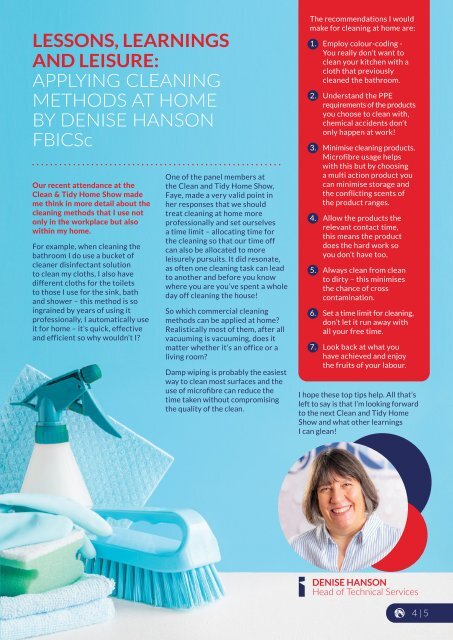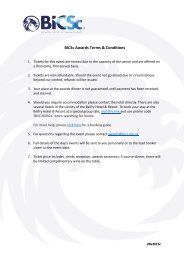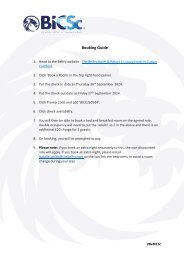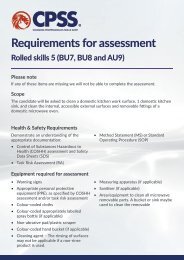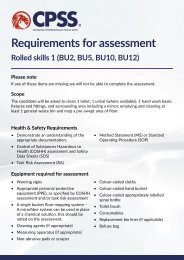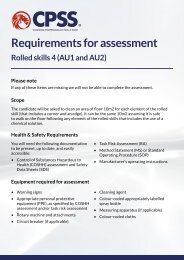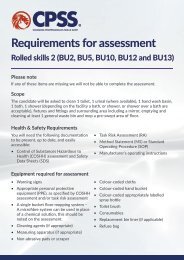The Standard Issue 4 2022
Create successful ePaper yourself
Turn your PDF publications into a flip-book with our unique Google optimized e-Paper software.
LESSONS, LEARNINGS<br />
AND LEISURE:<br />
APPLYING CLEANING<br />
METHODS AT HOME<br />
BY DENISE HANSON<br />
FBICSc<br />
Our recent attendance at the<br />
Clean & Tidy Home Show made<br />
me think in more detail about the<br />
cleaning methods that I use not<br />
only in the workplace but also<br />
within my home.<br />
For example, when cleaning the<br />
bathroom I do use a bucket of<br />
cleaner disinfectant solution<br />
to clean my cloths, I also have<br />
different cloths for the toilets<br />
to those I use for the sink, bath<br />
and shower – this method is so<br />
ingrained by years of using it<br />
professionally, I automatically use<br />
it for home – it’s quick, effective<br />
and efficient so why wouldn’t I?<br />
One of the panel members at<br />
the Clean and Tidy Home Show,<br />
Faye, made a very valid point in<br />
her responses that we should<br />
treat cleaning at home more<br />
professionally and set ourselves<br />
a time limit – allocating time for<br />
the cleaning so that our time off<br />
can also be allocated to more<br />
leisurely pursuits. It did resonate,<br />
as often one cleaning task can lead<br />
to another and before you know<br />
where you are you’ve spent a whole<br />
day off cleaning the house!<br />
So which commercial cleaning<br />
methods can be applied at home?<br />
Realistically most of them, after all<br />
vacuuming is vacuuming, does it<br />
matter whether it’s an office or a<br />
living room?<br />
Damp wiping is probably the easiest<br />
way to clean most surfaces and the<br />
use of microfibre can reduce the<br />
time taken without compromising<br />
the quality of the clean.<br />
<strong>The</strong> recommendations I would<br />
make for cleaning at home are:<br />
1. Employ colour-coding -<br />
You really don’t want to<br />
clean your kitchen with a<br />
cloth that previously<br />
cleaned the bathroom.<br />
2. Understand the PPE<br />
requirements of the products<br />
you choose to clean with,<br />
chemical accidents don’t<br />
only happen at work!<br />
3. Minimise cleaning products.<br />
Microfibre usage helps<br />
with this but by choosing<br />
a multi action product you<br />
can minimise storage and<br />
the conflicting scents of<br />
the product ranges.<br />
4. Allow the products the<br />
relevant contact time,<br />
this means the product<br />
does the hard work so<br />
you don’t have too.<br />
5. Always clean from clean<br />
to dirty – this minimises<br />
the chance of cross<br />
contamination.<br />
6. Set a time limit for cleaning,<br />
don’t let it run away with<br />
all your free time.<br />
7. Look back at what you<br />
have achieved and enjoy<br />
the fruits of your labour.<br />
I hope these top tips help. All that’s<br />
left to say is that I’m looking forward<br />
to the next Clean and Tidy Home<br />
Show and what other learnings<br />
I can glean!<br />
DENISE HANSON<br />
Head of Technical Services<br />
4 | 5


